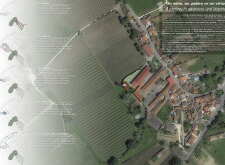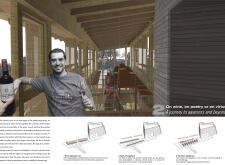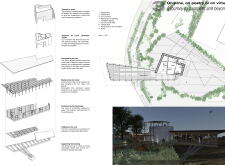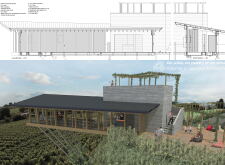5 key facts about this project
The facility serves multiple functions, including wine tasting, educational tours, and social gatherings, emphasizing flexibility within its interior spaces. The main tasting room is designed to adapt to different events, providing an environment conducive to both intimate tastings and larger workshops. The overall layout guides visitors through a sensory journey, encouraging engagement with the wine-making process and the rich history behind the vineyards.
Unique Design Approaches
This project distinguishes itself through its use of Cross Laminated Timber (CLT) as a primary material, combining structural performance with sustainability. CLT not only provides strength but also reduces environmental impact, aligning with contemporary architectural practices that prioritize ecological responsibility. The integration of large glass panels facilitates natural light, fostering an openness that connects the interior with vineyard views. This design choice supports a visual dialog between the inside spaces and the natural elements outside.
The roof design is notably dynamic, optimized for light and shading, which enhances the comfort levels within the facility. Additionally, the flooring concept, which incorporates both opaque and transparent materials, promotes an illusion of walking over the vineyard, blurring the line between built structure and natural landscape.
Experiential Elements
Within the facility, spaces are crafted to enhance the sensory experience of wine tasting. The upper terrace offers panoramic views of the vineyards, allowing visitors to immerse themselves in their surroundings. This area, along with the flexible tasting rooms, is not just for functional use; it invites spontaneous interactions and thoughtful reflections on wine and its cultural context.
Incorporating renewable technologies, including solar panels, further emphasizes the project's commitment to sustainability. The use of natural stone for cladding grounds the facility in its environment, promoting harmony between building and landscape.
For a comprehensive view of the project, including architectural plans, sections, and detailed design elements, readers are encouraged to explore the broader presentation of the facility. Each aspect of this project warrants deeper examination, showcasing valuable architectural ideas and innovative approaches to wine tourism.


























